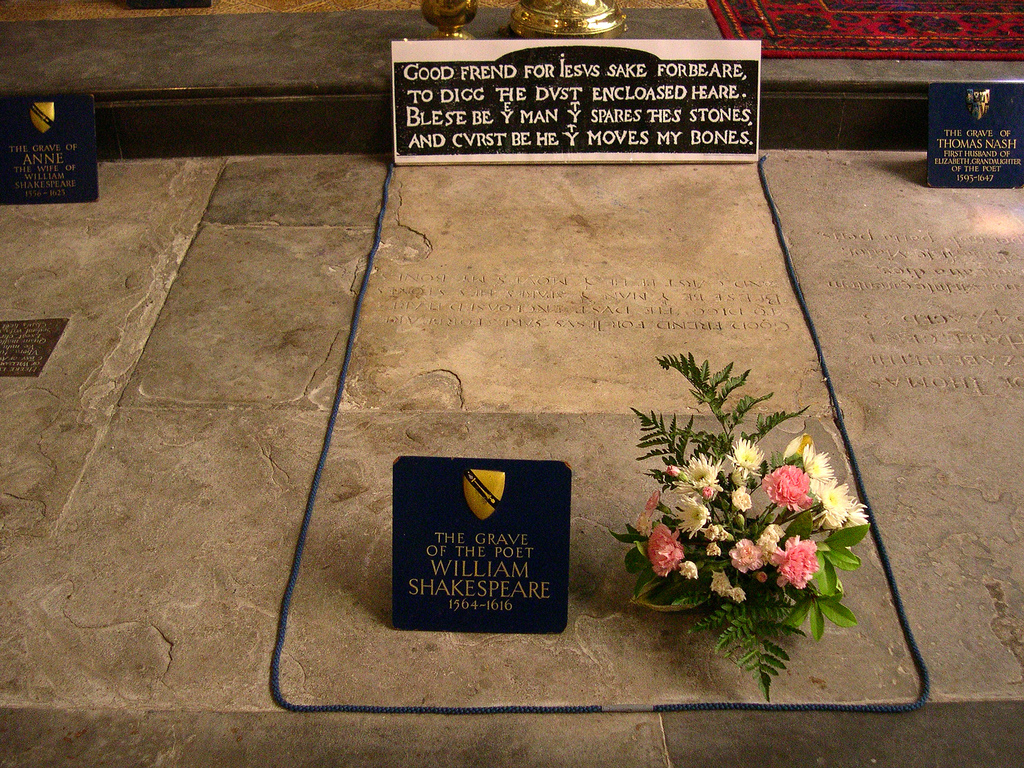Could Shakespeare's Bones Tell Us if He Smoked Pot?

A South African anthropologist has asked permission to open the graves of William Shakespeare and his family to determine, among other things, what killed the Bard and whether his poems and plays may have been composed under the influence of marijuana.
But while Shakespeare's skeleton could reveal clues about his health and death, the question of the man's drug use depends on the presence of hair, fingernails or toenails in the grave, said Francis Thackeray, the director of the Institute for Human Evolution at the University of Witwatersrand in Johannesburg, who floated the proposal to the Church of England.
Thackeray conducted a study in 2001, which found evidence of marijuana residueon pipe fragments found in Shakespeare's garden. Cannabis was grown in England at the time and was used to make textiles and rope. Some Shakespearian allusions, including a mention of a "noted weed" in Sonnet 76, spurred Thackeray's inquiry into whether Shakespeare may have used the mind-altering drug for inspiration.
"If there is any hair, if there is any keratin from the fingernails or toenails, then we will be in a position to undertake chemical analysis on extremely small samples for marijuana," Thackeray told LiveScience.
A poet's curse
Whether or not Shakespeare smoked pot, he certainly didn't want his remains disrupted. The stone covering the poet's grave carries an engraved curse for any would-be intruders.
"Blessed be the man that spares these stones," the engraving reads, "And cursed be he who moves my bones." [8 Grisly Archaeological Discoveries]
Get the world’s most fascinating discoveries delivered straight to your inbox.
Thackeray said he has a way around the Bard's curse.
"We don't want to move any of the bones," he said.
Instead, Thackeray said, the team plans to use a technique called laser surface scanning. With a portable device, he said, the anthropologists can open the graves and digitally scan the skeletons of buried in the graves that are supposed to belong to Shakespeare, his wife Anne Hathaway and his daughter Susanna without moving the bones. The scans could then be turned into three-dimensional computer models of the bones and skulls. From this information, the researchers can build facial reconstructions to confirm the skeletons' identities and look for markers of health and signs of disease in the bones.
Thackeray also pointed out a loophole in Shakespeare's curse.
"He does not refer to teeth," he said.
A very small sample of the inner portion of Shakespeare's tooth could provide DNA to definitively link him to the skeletons of his wife and daughter, Thackeray said. Chemical analysis of teeth can also reveal details about a person's diet as well as their smoking habits, though not whether he preferred tobacco or Mary Jane. Skeletons from Virginia of people who lived during Shakespeare's time show grooves between the canine and incisor teeth from habitual chewing on a pipe, Thackeray said. If Shakespeare was a habitual smoker, his own teeth might bear such grooves.
Digging up Shakespeare
A Church of England spokesperson told FoxNews.com last week that they had not received a petition from Thackeray to open the grave, which is located in the Church of the Holy Trinity in Stratford-upon-Avon. But Thackeray said the paperwork is in.
"The application has been submitted," he told LiveScience. "We are now just simply waiting for a formal response. … We respect the fact that it will take time to have our proposal examined and assessed."
Uncovering Shakespeare's bones could provide more information about the man behind "Hamlet" and "King Lear"than ever before, Thackeray said, adding that "there is very little known about his life."
But other anthropologists are skeptical. Analyzing the skeleton could reveal whether Shakespeare had certain conditions such as osteoporosis, Kristina Killgrove, a professor of anthropology at the University of North Carolina, Chapel Hill, told LiveScience. But determining cause of death is more difficult, unless the disease or disorder is one that affects the bones, she said.
And while the public may clamor for more information on historical icons, the scientific knowledge gleaned from such projects doesn't always add much to what is already known about an era, Killgrove said.
"I'm not a big fan of opening up the tombs of Mona Lisa or Shakespeare to see how they died," she said. "I'm not really sure what it will tell us other than the lifestyle of somebody in Elizabethan England."
You can follow LiveScience senior writer Stephanie Pappas on Twitter @sipappas. Follow LiveScience for the latest in science news and discoveries on Twitter @livescience and on Facebook.

Stephanie Pappas is a contributing writer for Live Science, covering topics ranging from geoscience to archaeology to the human brain and behavior. She was previously a senior writer for Live Science but is now a freelancer based in Denver, Colorado, and regularly contributes to Scientific American and The Monitor, the monthly magazine of the American Psychological Association. Stephanie received a bachelor's degree in psychology from the University of South Carolina and a graduate certificate in science communication from the University of California, Santa Cruz.
 Live Science Plus
Live Science Plus





